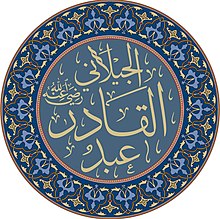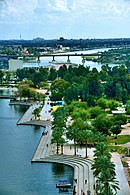|
Bab al-Sheikh
Bab al-Sheikh (Arabic: باب الشيخ, romanized: The Gate of the Sheikh) is an old neighborhood in the Rusafa side of Baghdad, Iraq. It is notable for being the location of the mausoleum of Sufi Sheikh Abd al-Qadir al-Gilani, founder of the Qadiriyya Order. The area is located in Bab al-Sharqi and next to al-Khilani Square. HistoryBackground The name “Bab al-Sheikh” translates to “The Gate of the Sheikh” and is a reference to the Sufi Sheikh Abd al-Qadir al-Gillani who's buried in a tomb in the same mosque in the area that also bares his name.[1] Abd al-Qadir al-Gilani was a respected Sufi Theologian and mystic who founded the Sufi Qadiriyya Order and a madrasa dedicated to it that bares its name where al-Gilani and his family lived in until his death in 1166 where he was buried in it. His order flourished and survived the Mongol destruction of Baghdad.[2] However, when Iranian Safavid Shah Isma'il I conquered Baghdad, he destroyed the shrine.[3] In 1534 Baghdad was conquered by the Ottoman Empire, Suleiman the Magnificent ordered a dome be built over al-Gilani's mausoleum.[4] The area was said to be established by Abbasid Caliph al-Mustazhir (1094-1118 CE) upon building one of the gates of Baghdad. Later during the reign of Abbasid Caliph al-Nasir in 1222, he built Bab al-Talsim in the area and renovated the area. This gate would be used by Ottoman Sultan Murad IV upon entering Baghdad in 1638. Bab al-Talsim would eventually be destroyed by Ottoman forces in 1917 just before the British Empire took over Iraq.[5] SettlementDuring the Ottoman Empire period, Bab al-Sheikh became a prominent safe spot for people fleeing the government. Due to this, the area was a refuge and did not allow them to be arrested by Ottoman Authorities. As such, it attracted the same reputation as Karbala for being a safe haven for those fleeing the Ottoman government. Bab al-Sheikh also became the source of many uprisings and demonstrations against the government.[6] Around 1831, when Ali Riza Pasha conquered Baghdad, representing the Ottoman Sultan's will, and took it back from the Mamluk Dynasty, some of Dawud Pasha's supporters went to hiding in Bab al-Sheikh, including Islamic scholar Mahmud al-Alusi, who was then interceded by the area's Mufti to work at al-Qadiriyya Madrasa.[7] Around the summer of 1848, uprisings in Bab al-Sheikh reached Bab al-Mu’adham. The uprisings were motivated by frustrations against the Wali's impalement of a taxation policy on the craftsmen. After repressing it, the Wali accused the shrine's preacher, Sayyid Muhammad Amin al-Wa’iz, of being among the instigators of the uprisings. Consequently, he banished him and several of his followers to Basra. Al-Alusi, the Mufti of the shrine at this point, was also banished to Basra where al-Alusi spent the rest of his life in hardship.[8] During the reign of Midhat Pasha, mandatory officer conscriptions were established by the Pasha. As a result, Bab al-Sheikh blew up with demonstrations against the conscription system. Several regressive protestors took arms and attacked the souks that belonged to Christians and Jews who were living in that area. Midhat Pasha heard their gunshots from his office and immediately ordered officers to protect the Christians and Jews.[9] Midhat Pasha then focused on arresting the demonstrators of Bab al-Sheikh who eventually got drafted into the Ottoman military.[10] Bab al-Sheikh was also home to several special gatherings for many families based in Baghdad. Among those were the Turkish al-Jorbaji family, which was known for being a philanthropist family,[11] Bayt al-Alaqband, a family that was well-known for teaching high positions in schools and the Qadiriyya madrasa,[12] and other gatherings for families of religious scholars.[13] Modern era In 1982, plans to develop Bab al-Sheikh as part of a wider development project were proposed. Because the street next to the old shrine connected to al-Khulafa Street, John Moutoussamy had plans to preserve many historic houses in the area. Previously, parts of the area were demolished to make parking lots. Due to this, the Baghdad Municipality was obligated to follow the advice of Iraqi architect Rifat Chadirji who didn't approve of old areas in Bab al-Sheikh being blindly given away for the sake of development.[14] The development of Bab al-Sheikh was planned to have public transportation and extend the Central Business District. However, due to the Iran-Iraq War and the Gulf War, these projects were never completed.[15] During the 2003 US-led invasion of Iraq, Bab al-Sheikh, similar to a lot of areas in Baghdad, saw a major decline in the medical, social, and job sectors. The area, including the Qadiriyya mausoleum, madrasa and library, were looted and vandalized by foreigners. Many of Bab al-Sheikh's people migrated which left the area in dire poverty.[16] Traditionally, the Abd al-Qadir al-Gilani Mosque held iftar and tarawih sessions during Ramadan with the mosque's kitchen cooking food for the people of the area. During the COVID-19 pandemic, the mosque was forced to close down until it was reopened for Ramadan in 2021 to let in visitors to break fast and perform tarawih.[17] Notable landmarksMausoleum of Abd al-Qadir al-GilaniThe Mausoleum of al-Gilani is located here and is where the neighborhood gets its name from. Al-Rawas MosqueAl-Rawas Mosque, located near al-Gilani Street, was founded and built by Sultan Abdul Hamid II in 1893. It had a madrasa and the tomb of Husaynid Sheikh Muhammad al-Rawas, after whom the mosque is named after, who died in 1875. Al-Rawas lived and worked in Bab al-Sheikh. The mosque was then demolished by the Baghdad Municipality in 1954 to pave al-Jumhuriya Street and the remains of Sheikh Muhammad al-Rawas were transferred to the cemetery of the Sayyid Sultan Ali Mosque. It is now recognized as one of the lost mosques of Baghdad.[18][19] People from Bab al-SheikhSee alsoReferences
Works cited
|
||||||||||||||||
Portal di Ensiklopedia Dunia

